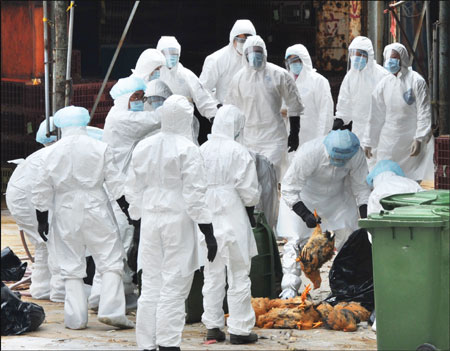Flu scare sparks mass bird cull
Updated: 2011-12-22 08:26
By Kahon Chan(HK Edition)
|
|||||||
|
Workers load dead chickens into plastic bags after the birds were killed at a wholesale poultry market in Cheung Sha Wan on Wednesday. Aaron Tam / Agence France-Presse |
Officials say the dead bird at public market raises no cause for alarm
Experts have reassured the people of Hong Kong that the discovery of a chicken infected with the potentially lethal H5N1 avian flu virus in a city market on Tuesday raises no cause for alarm.
As a safety precaution, a cull of 17,000 chickens was carried out on Wednesday.
York Chow, secretary for food and health, announced the test result before midnight on Tuesday.
Sales of live poultry in Hong Kong markets were placed on immediate hold for 21 days.
Local hospitals were told to raise their flu alert to "serious" as a precautionary measure.
A laboratory at the University of Hong Kong is now determining whether the virus strain found in the dead bird had mutated, which might make the virus vaccine-intolerant.
The 17,000 live chickens at the Cheung San Wan wholesale market were exposed to high-concentration carbon dioxide in an operation that began at about 11 am on Wednesday.
The remains were wrapped in black plastic bags to be disposed in a landfill.
Wholesalers will be paid HK$30 for each culled bird under an agreement reached in 2008.
The carcass of the infected bird was discarded on Tuesday morning.
Chow admitted there was a chance that other sick birds at the market had already been slaughtered and sold to the public later in the day.
Chow assured anxious consumers that there will be no danger from eating an infected bird, as long as it was properly cooked.
Experts also said the health risk is not as great as the mass cull might make it appear.
Yuen Kwok-yung, chair of infectious diseases at the Department of Microbiology of University of Hong Kong, said the next two weeks will be critical to determine how extensively the strain had spread since an infected bird may not show symptoms for a week after becoming infected.
Retail and wholesale markets are required to clear all live poultry by the end of trading every day.
Yuen thus suggested the dead chicken may have contracted the virus on the farm where it was reared.
Lo Wing-lok, a specialist in infectious disease, said overall risk remains low at the moment, as the infection has not turned into a massive outbreak and the prevalence of the virus in the environment is presumed to be low. Contagion risk for wholesale dealers and poulterers in direct contact with the livestock is slightly higher, but households where slaughtered chickens were handled do not arouse significant concern.
Chickens both from local farms and designated farms on the mainland are vaccinated and inspected before heading to the market, where carcasses are tested for virus.
The discovery and containment of the flu, as Lo pointed out, indicated the system is working.
Other than mutation of the flu viruses, Lo suspected chickens from an unauthorized supplier might have been mixed into the certified batch of chickens, in order to meet the high demand ahead of the Winter Solstice Festival.
But the investigation on how this particular chicken fell through the strict preventive regime has proven difficult, because individual chickens are not marked.
Origin of chickens can be tracked down by tags attached to the cage, but the authority can obtain no information about carcasses discarded into the collection bucket.
York Chow said it was "a good question" to ask if a leg band could be fitted to each chicken at the poultry farms both in Hong Kong and on the mainland - he said he will look into the feasibility of the idea in conjunction with relevant agencies across the border.
The New Territories Chicken Breeders Association had doubted whether its members have sufficient staff to fit a band on every bird. Vice-Chairman Lee Leung-kei asked for financial support from the government if the HK$1 band becomes mandatory.
So far, chickens at local farms have been spared from any bird culls, since no outbreak was visible during inspection of all but one of the 30 local poultry farms on Wednesday morning. Samples were collected for further virus tests.
The alarm went off earlier this month after two wild bird carcasses were found in the New Territories. Both tested positive for the H5N1 flu virus.
kahon@chinadailyhk.com
China Daily
(HK Edition 12/22/2011 page1)
